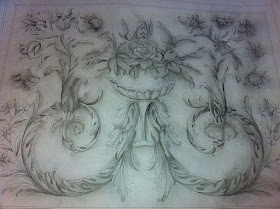
Well, another year is put in the memory bin. It seems like such an arbitrary moment to change everything and start over. All the invoices, bills and receipts get filed into boxes. New folders are in place, ready to receive new invoices, bills and receipts. New calendars are on the wall, already filling up with dates and events which are planned in the next few months.
It seems rather arbitrary to me, since I am a native of Southern California, and there is no actual climate change to signal the end or start of the seasons. It will be in the mid 70s today, sun shining, clear skies, no breeze, just like any other day. I am at work, doing what I always do, just like every day. Pick up trash, put away tools, sharpen chisels, sweep the floor, heat the glue and repair something valuable, talk to clients, and in general just solve problems.
The one thing unusual about the start of the year is that I tend to get rather nostalgic. I often think back over the years and reflect how my life is the culmination of events and decisions which seemed insignificant at the time, but later proved to be decisive and very significant. I am fortunate to be in business and thank my clients for their support all the time. I frequently have clients who mention that I worked on something for them "years ago" and they were very happy with the results. I also have younger clients who mention I worked for their parents or grandparents and now they need me to do a project for them.
Having never believed in spending money of traditional advertising, I realize how important it is to have my named passed around by "word of mouth". It takes years to build a good reputation and only a few mistakes to destroy it. That is why I have always gone out of my way to make the customer happy with my work.
For example, early on in my career I had a decorator client who brought me a standard upholstered club chair. Not really an antique, but a nice frame made in the 1930s. She had picked out a very wild and contemporary fabric that looked like a Jackson Pollack painting. I proceeded to upholster the chair, which took some time. When she came to pick it up, she was shocked. "You put the fabric on wrong side out!" she exclaimed. I showed her the surplus roll of material, and how you can tell the front surface from the back. "This is a brocade weave," I explained, "and the pattern is made by pulling different colors of thread from the back through to the front surface. If you look on the back side, you can see all the loose threads which are not part of the pattern. The front side is smooth and finished." "No," she answered, "the back side is the show surface. I expected you to know that!"
So I took all the material off the chair, turned it carefully over, and put it back in place, wrong side out. She was happy with the results, and I never heard from her again.
Another time, I picked up two reproduction French armchairs with new white upholstery. The beechwood frames were painted a dark color. She asked me to refinish them "natural". I went through a lot of trouble to protect the upholstery, as I used paint remover to remove all the paint, sand the wood and apply a clear shellac finish and wax. When she saw them, she was shocked. "I asked you for a natural finish!" she exclaimed. "Like that!" and she pointed to a piece of "shabby chic" which had been painted white, then rubbed with solvents until most of the paint was worn off.
I returned with the chairs, covered the fabric again and painted them white. The client was happy with the results, and I never heard from her again.
Those clients are part of the past. It took years for me to recognize the subtle hints which indicate whether the client is right for me or not. During the early years, I took every job which walked in the door. I met a lot of people who liked what I did and some who were never satisfied, no matter what the result was. I learned to avoid the latter. It is much easier to walk away and not look back then to get involved with a project that can have no successful conclusion.
These days, because of "word of mouth" and lots of kind articles which have been written about me, I seem to get wonderful jobs and satisfied clients most of the time. In my business, getting references and work is like a miner who discovers a gold streak in the earth. By working for clients with nice pieces, I get referred to other clients with nice pieces. And so it goes...
Certainly the past year was a challenge in many ways. Compared to the year before, it was somewhat better, and I am always optimistic. In the long run, it all averages out. The antique business is a wonderful business. The objects are often extraordinary, the clients are involved, and there is always something new to learn about the masterpieces of the past.
I look back on the choices I have made in the past and wouldn't change a thing. It is always exciting to see what new project will arrive tomorrow.










